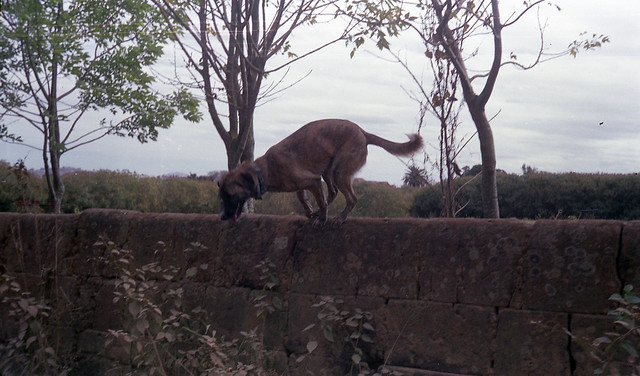I finally got around to shooting with a camera I’ve had for quite some time, the Kodak Pony 828, a bakelite camera produced from 1949 to 1959, as a transition between rollfilm and 35mm film. I have actually owned two of these, but the first had a sticky shutter and I passed it on to someone else.

The Pony 828 still uses a small version of rollfilm but was quickly followed by the Pony 135, using 35mm film. The 828 film roll is a small roll – smaller than 127. It’s the width of 35mm film, but designed to produce an exposure that is 28mm by 40mm, rather than 24x36mm. In other words, 35mm film would work, were it not for the perforations.
I bought “828” film (for too much money), which I thought would be unperforated, but was really just Tri-X rolled inside an 828 backing paper. So my first set of exposures extended onto the perforations area, but the film holder for my scanner can’t handle that, so my exposures ended up being 24x40mm. To make matters worse, it seems that 828 film only includes 8 exposures. Between the exposures are 20mm gaps, meaning if the backing paper were marked to maximize the space available, they could have easily fit 14 or 15 exposures.
The camera is simple. It sold for $30 in 1950, which was not cheap, and it is pretty much manual everything. The lens/shutter assembly is retractable. To take a picture, you set your shutter speed (up to 1/200s); your aperture (from f/4.5 to f/22); and after estimating the distance to your subject (can be from 2.5 feet to infinity), manually focus. And then you cock the shutter. Now you’re ready to shoot.
I was initially disappointed with my first roll, the respoooled Tri-X. But the issue was mainly user error. The Pony 828 has a decent lens, made out of glass and comprised of multiple elements, and the film was forgiving. But I was framing in a hurry. Consequently, some of my shots were off target and I won’t bother sharing them. But the ones I’m sharing were respectable for a 70-year-old camera.
Others were blurry because I didn’t estimate distances properly, or flat out forgot to focus.
However, realizing that this “fancy” 828 film I had bought was simply respoooled Tri-X 35mm, I decided I would try another roll. So I spooled some Fuji 400H. These photos turned out much better.

Using the manual focus, despite shooting in f/11, I was able to create some bokeh and have the background be out of focus.

At the same time, when I took a wider landscape shot, everything was nicely in focus. I’ll admit I only shot at 1/200s – since I was using 400 speed film and I didn’t have a whole lot of f-stops to play with – but this was sufficient to freeze movement.
All eight of my color photos turned out the way they were intended. The down side of this camera is (a) I feel like the colors were a bit muddy. Increasing exposure might help this a bit. In addition, you might notice in all of the color exposures that there is some scratching of the negatives. This could be a result of my poor film winding job – but since they don’t make 828 film anymore, this is going to be a fact of life with this camera. Lastly, I’ll just reiterate the fact that there are only eight exposures per roll. This fact alone makes me wonder why they produced this camera for a full ten years.
 Always fun, however, to shoot an old camera and see how it performs!
Always fun, however, to shoot an old camera and see how it performs!






My 89-year-old mother-in-law shot scads of Kodachrome slides, many of them on 828 film, almost certainly on one of these (as one was found with the slides). They were sort of “pro-sumer” cameras of their day thanks to their capable lenses and range of shutter speeds and apertures.
Pingback: Recommended reading : Down the Road